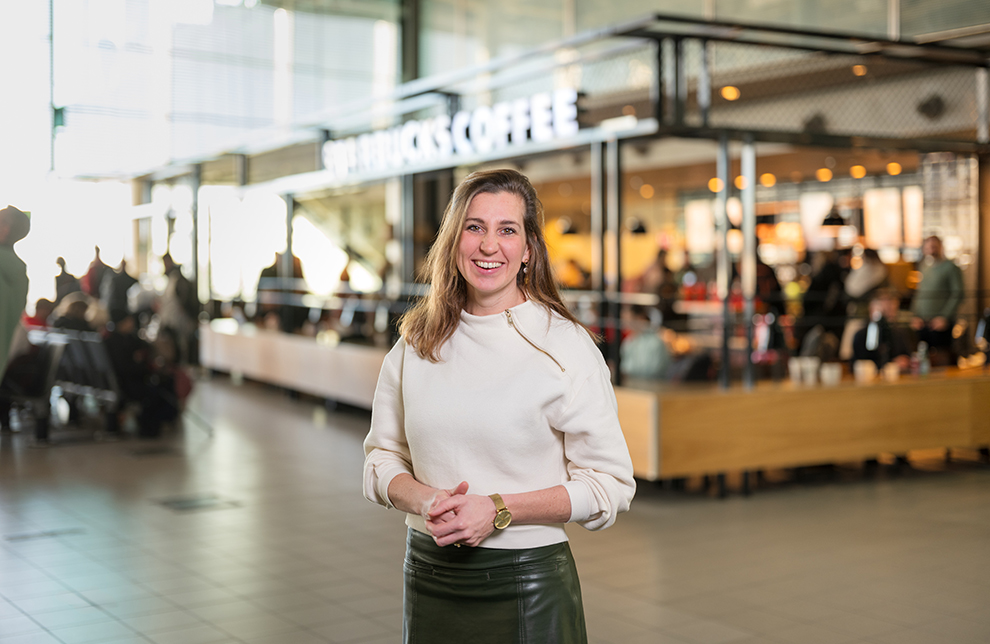Overhaul of catering concepts at Schiphol:: ‘We must become leading again’
Published on: 27 February 2024
Lounge 1 will have more than 5,000 m2 of extra space after its redevelopment. That’s a lot of additional square metres that of course need to be used. This is exactly what Anne-Lou Dijkman-van Wijk, concept developer Food & Beverage at Schiphol Commercial, thought. We talked to her about hidden restaurant gems, Amsterdam’s terraces and how you make future-proof catering concepts.

Anne-Lou, new catering concepts in Lounge 1 – was that necessary?
‘We had some ingredients ready to be experimented with. Additional square metres, new directions of motion and lines of sight – you soon start to consider what the best setup would be for the passengers. Some existing concepts will remain in the lounge, but space has been made for new ones too.’ Anne-Lou counts on her fingers: ‘Bread, Starbucks, Salon GrandCafé, Salon Deli, Taste Room, Grab & Fly and De Koffiesalon’.
So that’s seven. How do you know that passengers want these catering concepts?
It’s not guesswork. We have a special Customer Insight Team that collects data from all airports and compares them based on how satisfied passengers are. Long story short, we’re not in good shape. We were previously in the top three, but now we’re bottom of the class when you compare us with Copenhagen, Istanbul and other European hub airports. As Schiphol, we want to be a leader. That’s why we are changing course. A diverse range of options that exceeds passenger expectations and is leading in terms of hospitality and quality.
What did the data show exactly?
That change was urgently needed. A good example is bread – passengers indicated that they consider the range of bread products too wide. That may sound strange to a Dutch person, but passengers said they want international options as well as local ones. There’s also demand for more warm meals and healthier options. I see this as an opportunity to offer more variety. Moreover, a good range of food and drink outlets contributes to passengers’ experience of Schiphol. That provides perspective. Improved catering services means an improved airport experience. That’s beneficial to our turnover and to the turnovers of business partners like HMSHost and De Koffiesalon.
So your task is basically: you ask, we deliver?
That’s partially the case. For us – and by that I am mainly referring to my colleague Bram Kreté with whom I focus on Food & Beverage – passenger experience is top priority. That’s why we now respond more dynamically to passenger feedback. They want recognisable brands? We invite those brands to set up shop at Schiphol. Besides the ‘you ask, we deliver’ part, there’s the drive to keep surprising passengers. What we’re doing in Lounge 1, for example, is based on the vision: ‘Providing a place for new Dutch brands and concepts at Schiphol’. This gives them the opportunity to become known to an international audience.
What kind of surprises for passengers do you have in mind?
If I told you, it wouldn’t be a surprise anymore. But what I will reveal is that we are going to work with ‘shop-in-shops’. This means that we connect business partners together, which creates a nice dynamic. Take De Koffiesalon & AKO, for instance. Soon, readers will be able to walk to the back of the shop, to a lovely quiet place away from the hustle and bustle of the lounge, with their new book in hand and drink a cup of coffee while reading. It’ll be a hidden gem that only Schiphol aficionados know about. That includes the readers of this blog.
A hidden gem, sounds good. And what about the look and feel of the catering outlets? What can we expect?
Sense of place is important to us. Even passengers who purely use Schiphol for transfers should be able to see that they are in Amsterdam/the Netherlands. We subtly reflect this in Salon GrandCafé, for example, which resembles an open terrace in Amsterdam where you can see the setting sun and where food and drinks are served. And at Salon Deli, passengers can sample Dutch delicacies and local products. There are poetic references to polders, and the Salon’s entire framework is a homage to canal buildings.
And how do you ensure that a concept remains ‘timeless’?
By making sure that you remain flexible. You need the space and freedom to go along with the developments. And we give that to our business partners, they always do that well. We monitor the most important matters: tasty food and fast service. After the redevelopment we’ll be making more use of digital order kiosks and QR codes, giving passengers more autonomy. These are all points that emerged from our research, which is why digitalisation is one of the themes we’ll be focusing on more in the development process of upcoming catering concepts. And yes, sustainability cannot go unmentioned when talking about future-proofing.
OK, let’s talk about sustainability. How is that apparent to the passenger?
Sometimes it’s visible, at other times it isn’t. That varies. Modular construction cannot directly be seen. However, the sustainable materials used, such as bamboo, can be. We have a whole list of ambitions here too. From halving the CO₂ emissions of food production to a zero-waste strategy in 2030 that will specifically enable catering locations to become more sustainable. Still, things are not moving as fast as we would like.
Why is that?
It would otherwise become too expensive. Imagine we made everything organic and/or limited the supply of meat – prices would skyrocket. We’re doing things gradually by working with business partners to find the right product quality, with a good flavour, decent price and just the right amount. That way, we can avoid shrinkflation. We’re still searching for ways to achieve that because, as I previously mentioned, the passenger experience is our top priority. But it’s this search that makes my work so exciting.